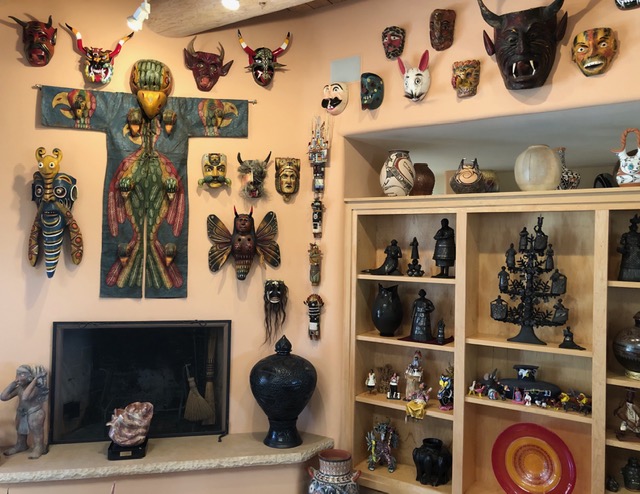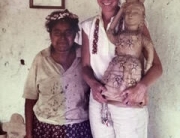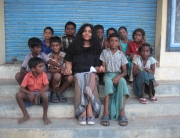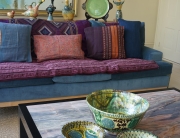
Our fascination with masks started in 1994 on a family trip to San Miguel de Allende during Semana Santa. My husband Michael and I fell in love with a mask of a hornblower with a feathered headdress and couldn’t wait to see more masks. At a local mask shop, I had to rein in our two teenage sons as well as my husband who were attracted to the most bizarre and creepy ones. “Guys, we have to live with these!” I’d implored, and they agreed to tone it down. The fascination with masks has continued. We buy what we like regardless of whether they have been danced or not, a criteria for some collectors. Masks from Guerrero, Mexico seem to predominate, though we had a great time buying from the Horta brothers who came to the Market in 2014 from Michoacan. In the photo, the two devil masks on the top above the fireplace (2nd and 4th from left) are made by them.
Now a variety of faces look down on us from all four walls of our living room. The masks have gotten a bit more intense over the years and now include many devils, faces with insects crawling over them, tongues protruding, bushy eyebrows, lots of horns. In the photo, the “glow worm” and Ms.Devil Moth above the fireplace are from the San Miguel trip.
I would say Michael and I are “accumulators” rather than collectors, but our passion for folk art goes back to the mid-sixties, even before we were married. Folk art was everywhere in Ann Arbor during those hippie anti-war years. It was the time of Indian bedspreads, peasant blouses, and ethnic foods, all easily affordable. We started buying functional pottery from local potters. I pierced my ears and started wearing dangling Indian earrings. A friend gave us a Guatemalan weaving, and another friend brought us a piece of batik from Java, both of which we hung on the wall. Two Taiwanese aboriginal carved wood panels which I bought during my junior year abroad are still on the wall.
In 1975 we ditched good jobs in LA and took off for Japan to study bonsai. Our love of ceramics was well nurtured in Japan where it is an important part of the culture. We visited many of the famous Japanese folk pottery kilns and are still eating off of those same dishes 44 years later. Our collection of pottery from Japan, the U.S., and Mexico has continued to grow over the years. We like to sponsor new artists who come to the Folk Art Market, especially those who work in ceramics.
In 1984 we went to Mexico for the first time and fell in love with Mexican folk art. Most likely it was then that we decided that the minimalist Japanese esthetic really wasn’t our style! There were subsequent trips to Oaxaca in 1990 and other places. On several trips to Seattle, the Milagros Mexican Folk Art gallery offered up many curated pieces for our home, including the macaw dance costume over the fireplace and the Noah’s Ark ensemble by Josefina Aguilar on the open shelves below the Tree of Life.
We first heard about the International Folk Art Market on a trip to Santa Fe in 2007 while we were buying a large Peruvian retablo mirror at the Museum of International Folk Art gift shop. The following year we came to the Market, rode the bus up from the PERA lot just before the 9:00 am opening, and fell in love with the Market. At that time we never dreamed our subsequent involvement with the Market would lead us to buy a house in Santa Fe and move here 3 years later! But it is clear in hindsight that the die was cast.
At that first Market, we walked by a booth where a lovely black clay figurine of a woman had just been put out for sale. Someone had decided not to buy it, so we grabbed it. She is the tall figure on the right on the top left shelf. It was our first piece by Magdalena Pedro Martinez who crafts detailed female figurines dressed in the traditional costumes of her native Oaxaca. We have bought many more of Magdalena’s beautiful pieces over the years and now count her as a beloved friend. You can see some of her pieces on the open shelves in the photo. A few years ago we were in her small workshop at her home in San Bartolo de Coyotepec as she talked about her art when we noticed the magnificent Tree of Life with figures depicting the eight regional costumes of Oaxaca state. It was still a work in progress, and we arranged to purchase it from her. You can see it has pride of place on our display shelves. The large open-worked black pottery urn on the hearth is also from San Bartolo, crafted by Pedro Silva, who makes the form, and Josefina Mateo, who carves by hand, mostly with an Exacto-knife and without a pre-drawn pattern. We love its elegant shape.
Our home is filled with folk art in every room: Peruvian retablos in the sitting room, Mexican ceramic sirenas in the master bath, Mexican plates in the dining room, pottery of all kinds all over the house, textiles scattered here and there. We love all the colors and the fact that each piece was made by hand, often by an artist we have met in our travels or at the Folk Art Market. Our sons think it’s time we stopped buying folk art, but we buy what makes us happy, and we enjoy it all. Besides, as my husband says frequently, “if you aren’t buyin’, you’re dyin’.”
*****
Laurie and Michael Vander Velde moved to Santa Fe from St. Louis, MO in 2011 and brought their folk art with them, including many pieces that had been bought in Santa Fe. Since then, many wonderful pieces have been added to their collection. IFAM is what drew them to Santa Fe. They served as co-chairs of the Market Signs committee at the Market for six busy years, from 2012 to 2017. The Vander Veldes resigned from that position so they could celebrate their 50th wedding anniversary in 2018, but they continue to volunteer for the Market in various ways. Michael is currently on the IFAM Board of Directors. Laurie is co-chair of the Artist Resource Fair for the 2021 Market.





